Twodollarcherricola - Vash!






More Posts from Twodollarcherricola and Others
I am sorry in advance to my handful of followers for the person I am about to become when The Golden Raven drops
why do some people insist on characterising livio as being appalled or shocked or scared or whatever by razlo's actions, like it isn't a point in the manga that livio shouldered all of the hard shit onto razlo (and felt bad about and apologised to him for it later btw), like livio isn't Also a Death Cult Raised Murdering Super Assassin who was prized by the eye because he was a Very Good Death Cult Raised Murdering Super Assassin 😑 razlo isn't really even any more violent than livio (or wolfwood for that matter), he just likes to have fun when he fights.
like you know livio made the choice to kill people for the eye, right? don't forget that about him. that agency of him deliberately choosing to do bad is crucial to his heelface and new lease on life later on. i think maybe a lot of you guys are just fucking weird about systems and think "evil alters" are actually a thing bc you saw a couple bad horror movies and want to malign razlo to--what, exactly? make livio look weaker and more innocent than he actually is? he kills people. he's a gung ho gun. he's one of the eye's best. he was totally fine with threatening the orphanage and using the kids as bait for wolfwood.
Words for Skin Tone | How to Describe Skin Color
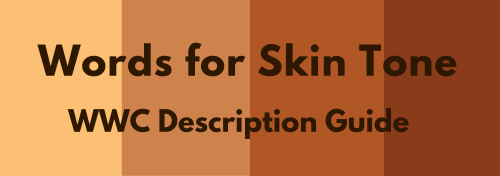
We discussed the issues describing People of Color by means of food in Part I of this guide, which brought rise to even more questions, mostly along the lines of “So, if food’s not an option, what can I use?” Well, I was just getting to that!
This final portion focuses on describing skin tone, with photo and passage examples provided throughout. I hope to cover everything from the use of straight-forward description to the more creatively-inclined, keeping in mind the questions we’ve received on this topic.
Standard Description
Basic Colors

Pictured above: Black, Brown, Beige, White, Pink.
“She had brown skin.”
This is a perfectly fine description that, while not providing the most detail, works well and will never become cliché.
Describing characters’ skin as simply brown or beige works on its own, though it’s not particularly telling just from the range in brown alone.
Complex Colors
These are more rarely used words that actually “mean” their color. Some of these have multiple meanings, so you’ll want to look into those to determine what other associations a word might have.

Pictured above: Umber, Sepia, Ochre, Russet, Terra-cotta, Gold, Tawny, Taupe, Khaki, Fawn.
Complex colors work well alone, though often pair well with a basic color in regards to narrowing down shade/tone.
For example: Golden brown, russet brown, tawny beige…
As some of these are on the “rare” side, sliding in a definition of the word within the sentence itself may help readers who are unfamiliar with the term visualize the color without seeking a dictionary.
“He was tall and slim, his skin a russet, reddish-brown.”
Comparisons to familiar colors or visuals are also helpful:
“His skin was an ochre color, much like the mellow-brown light that bathed the forest.”
Modifiers
Modifiers, often adjectives, make partial changes to a word.The following words are descriptors in reference to skin tone.
Dark - Deep - Rich - Cool
Warm - Medium - Tan
Fair - Light - Pale
Rich Black, Dark brown, Warm beige, Pale pink…
If you’re looking to get more specific than “brown,” modifiers narrow down shade further.
Keep in mind that these modifiers are not exactly colors.
As an already brown-skinned person, I get tan from a lot of sun and resultingly become a darker, deeper brown. I turn a pale, more yellow-brown in the winter.
While best used in combination with a color, I suppose words like “tan” “fair” and “light” do work alone; just note that tan is less likely to be taken for “naturally tan” and much more likely a tanned White person.
Calling someone “dark” as description on its own is offensive to some and also ambiguous. (See: Describing Skin as Dark)
Undertones
Undertones are the colors beneath the skin, seeing as skin isn’t just one even color but has more subdued tones within the dominating palette.
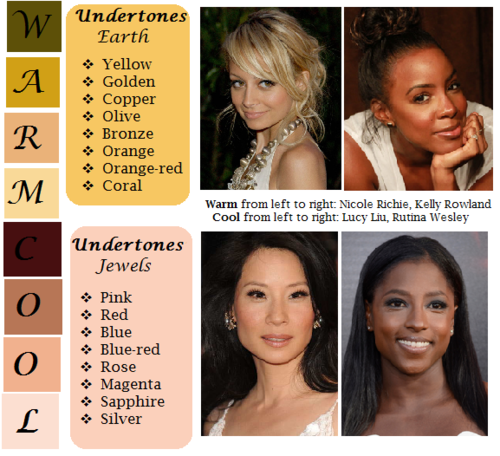
pictured above: warm / earth undertones: yellow, golden, copper, olive, bronze, orange, orange-red, coral | cool / jewel undertones: pink, red, blue, blue-red, rose, magenta, sapphire, silver.
Mentioning the undertones within a character’s skin is an even more precise way to denote skin tone.
As shown, there’s a difference between say, brown skin with warm orange-red undertones (Kelly Rowland) and brown skin with cool, jewel undertones (Rutina Wesley).
“A dazzling smile revealed the bronze glow at her cheeks.”
“He always looked as if he’d ran a mile, a constant tinge of pink under his tawny skin.”
Standard Description Passage
“Farah’s skin, always fawn, had burned and freckled under the summer’s sun. Even at the cusp of autumn, an uneven tan clung to her skin like burrs. So unlike the smooth, red-brown ochre of her mother, which the sun had richened to a blessing.”
-From my story “Where Summer Ends” featured in Strange Little Girls
Here the state of skin also gives insight on character.
Note my use of “fawn” in regards to multiple meaning and association. While fawn is a color, it’s also a small, timid deer, which describes this very traumatized character of mine perfectly.
Though I use standard descriptions of skin tone more in my writing, at the same time I’m no stranger to creative descriptions, and do enjoy the occasional artsy detail of a character.
Creative Description
Whether compared to night-cast rivers or day’s first light…I actually enjoy seeing Characters of Colors dressed in artful detail.
I’ve read loads of descriptions in my day of white characters and their “smooth rose-tinged ivory skin”, while the PoC, if there, are reduced to something from a candy bowl or a Starbucks drink, so to actually read of PoC described in lavish detail can be somewhat of a treat.
Still, be mindful when you get creative with your character descriptions. Too many frills can become purple-prose-like, so do what feels right for your writing when and where. Not every character or scene warrants a creative description, either. Especially if they’re not even a secondary character.
Using a combination of color descriptions from standard to creative is probably a better method than straight creative. But again, do what’s good for your tale.
Natural Settings - Sky

Pictured above: Harvest Moon -Twilight, Fall/Autumn Leaves, Clay, Desert/Sahara, Sunlight - Sunrise - Sunset - Afterglow - Dawn- Day- Daybreak, Field - Prairie - Wheat, Mountain/Cliff, Beach/Sand/Straw/Hay.
Now before you run off to compare your heroine’s skin to the harvest moon or a cliff side, think about the associations to your words.
When I think cliff, I think of jagged, perilous, rough. I hear sand and picture grainy, yet smooth. Calm. mellow.
So consider your character and what you see fit to compare them to.
Also consider whose perspective you’re describing them from. Someone describing a person they revere or admire may have a more pleasant, loftier description than someone who can’t stand the person.
“Her face was like the fire-gold glow of dawn, lifting my gaze, drawing me in.”
“She had a sandy complexion, smooth and tawny.”
Even creative descriptions tend to draw help from your standard words.
Flowers
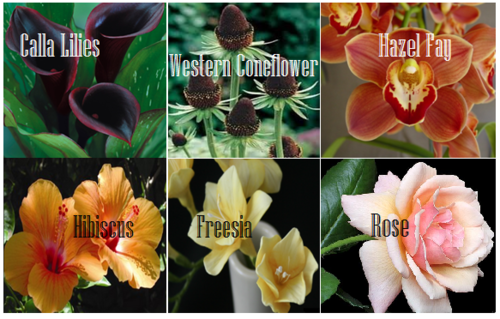
Pictured above: Calla lilies, Western Coneflower, Hazel Fay, Hibiscus, Freesia, Rose
It was a bit difficult to find flowers to my liking that didn’t have a 20 character name or wasn’t called something like “chocolate silk” so these are the finalists.
You’ll definitely want to avoid purple-prose here.
Also be aware of flowers that most might’ve never heard of. Roses are easy, as most know the look and coloring(s) of this plant. But Western coneflowers? Calla lilies? Maybe not so much.
“He entered the cottage in a huff, cheeks a blushing brown like the flowers Nana planted right under my window. Hazel Fay she called them, was it?”
Assorted Plants & Nature

Pictured above: Cattails, Seashell, Driftwood, Pinecone, Acorn, Amber
These ones are kinda odd. Perhaps because I’ve never seen these in comparison to skin tone, With the exception of amber.
At least they’re common enough that most may have an idea what you’re talking about at the mention of “pinecone."
I suggest reading out your sentences aloud to get a better feel of how it’ll sounds.
"Auburn hair swept past pointed ears, set around a face like an acorn both in shape and shade.”
I pictured some tree-dwelling being or person from a fantasy world in this example, which makes the comparison more appropriate.
I don’t suggest using a comparison just “cuz you can” but actually being thoughtful about what you’re comparing your character to and how it applies to your character and/or setting.
Wood

Pictured above: Mahogany, Walnut, Chestnut, Golden Oak, Ash
Wood can be an iffy description for skin tone. Not only due to several of them having “foody” terminology within their names, but again, associations.
Some people would prefer not to compare/be compared to wood at all, so get opinions, try it aloud, and make sure it’s appropriate to the character if you do use it.
“The old warlock’s skin was a deep shade of mahogany, his stare serious and firm as it held mine.”
Metals

Pictured above: Platinum, Copper, Brass, Gold, Bronze
Copper skin, brass-colored skin, golden skin…
I’ve even heard variations of these used before by comparison to an object of the same properties/coloring, such as penny for copper.
These also work well with modifiers.
“The dress of fine white silks popped against the deep bronze of her skin.”
Gemstones - Minerals
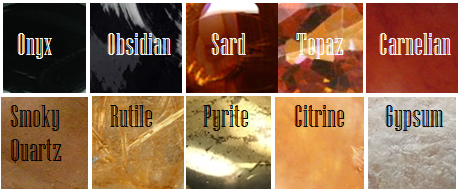
Pictured above: Onyx, Obsidian, Sard, Topaz, Carnelian, Smoky Quartz, Rutile, Pyrite, Citrine, Gypsum
These are trickier to use. As with some complex colors, the writer will have to get us to understand what most of these look like.
If you use these, or any more rare description, consider if it actually “fits” the book or scene.
Even if you’re able to get us to picture what “rutile” looks like, why are you using this description as opposed to something else? Have that answer for yourself.
“His skin reminded her of the topaz ring her father wore at his finger, a gleaming stone of brown, mellow facades.”
Physical Description
Physical character description can be more than skin tone.
Show us hair, eyes, noses, mouth, hands…body posture, body shape, skin texture… though not necessarily all of those nor at once.
Describing features also helps indicate race, especially if your character has some traits common within the race they are, such as afro hair to a Black character.
How comprehensive you decide to get is up to you. I wouldn’t overdo it and get specific to every mole and birthmark. Noting defining characteristics is good, though, like slightly spaced front teeth, curls that stay flopping in their face, hands freckled with sunspots…
General Tips
Indicate Race Early: I suggest indicators of race be made at the earliest convenience within the writing, with more hints threaded throughout here and there.
Get Creative On Your Own: Obviously, I couldn’t cover every proper color or comparison in which has been “approved” to use for your characters’ skin color, so it’s up to you to use discretion when seeking other ways and shades to describe skin tone.
Skin Color May Not Be Enough: Describing skin tone isn’t always enough to indicate someone’s ethnicity. As timeless cases with readers equating brown to “dark white” or something, more indicators of race may be needed.
Describe White characters and PoC Alike: You should describe the race and/or skin tone of your white characters just as you do your Characters of Color. If you don’t, you risk implying that White is the default human being and PoC are the “Other”).
PSA: Don’t use “Colored.” Based on some asks we’ve received using this word, I’d like to say that unless you or your character is a racist grandmama from the 1960s, do not call People of Color “colored” please.
Not Sure Where to Start? You really can’t go wrong using basic colors for your skin descriptions. It’s actually what many people prefer and works best for most writing. Personally, I tend to describe my characters using a combo of basic colors + modifiers, with mentions of undertones at times. I do like to veer into more creative descriptions on occasion.
Want some alternatives to “skin” or “skin color”? Try: Appearance, blend, blush, cast, coloring, complexion, flush, glow, hue, overtone, palette, pigmentation, rinse, shade, sheen, spectrum, tinge, tint, tone, undertone, value, wash.
Skin Tone Resources
List of Color Names
The Color Thesaurus
Skin Undertone & Color Matching
Tips and Words on Describing Skin
Photos: Undertones Described (Modifiers included)
Online Thesaurus (try colors, such as “red” & “brown”)
Don’t Call me Pastries: Creative Skin Tones w/ pics I
Writing & Description Guides
WWC Featured Description Posts
WWC Guide: Words to Describe Hair
Writing with Color: Description & Skin Color Tags
7 Offensive Mistakes Well-intentioned Writers Make
I tried to be as comprehensive as possible with this guide, but if you have a question regarding describing skin color that hasn’t been answered within part I or II of this guide, or have more questions after reading this post, feel free to ask!
~ Mod Colette

JEREJEAN IS REALLY COMING HOME.
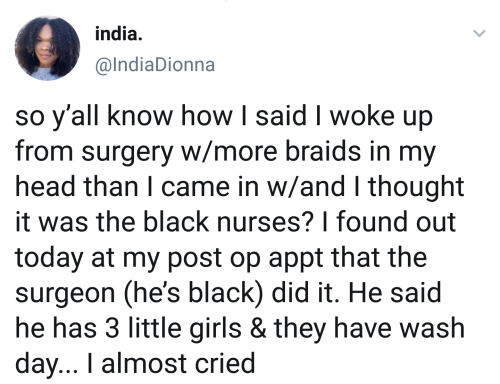
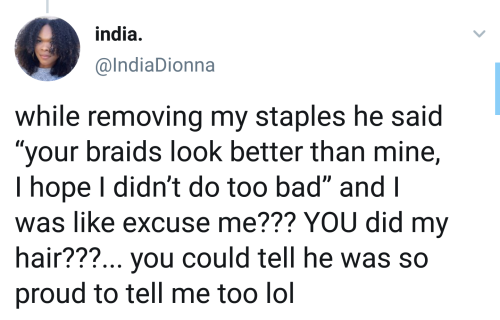

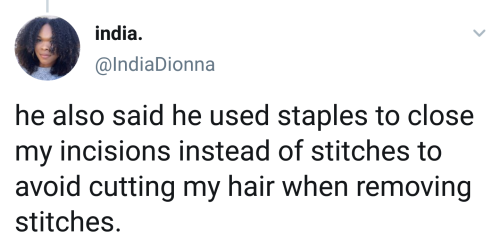

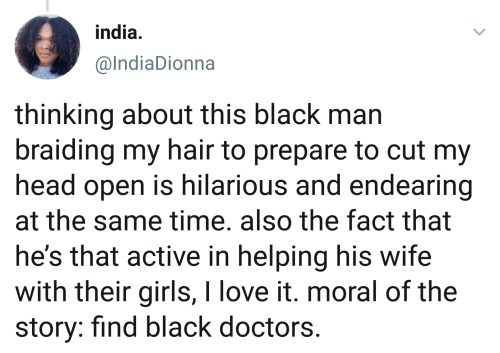
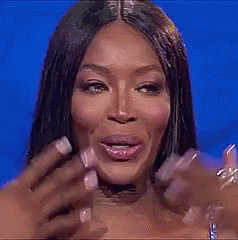
awesome story. black doctors and nurses are the best.




ICE raids happening in Chicago on Tuesday January 21st. Get organized and get prepared.
"sadistic freak" and "pervert" very easily two of the best traits a character with healing powers can exhibit
If this post gets 80085 notes I will finally stop boymoding in public
Need to ramble a bit about Livio in Stampede, have had thoughts tumbling around my head for a bit and need to put em out somewhere-
For a while I think I’ve been on the fence about the character that’s been portrayed for him so far in the anime- ill very readily admit I’m biased, as the manga version of him and Razlo I can easily say have been my favorite characters from any story I’ve experienced thus far and have been for quite a few years now.
As much as I joke or whine about his size in Stampede I think his design is fine on its own, it portrays what his character is supposed to be- a clean cut professional hitman/assassin that’s tied to this universe’s tech. I can also appreciate the concept of him constantly chasing after Wolfwood, I think there’s a lot that can be worked with there- but there’s an issue with the sense of his agency with that, which I’ll get into more.
It’s difficult not to compare Stampede to the manga, I understand that it’s supposed to be “its own thing”- but in regards to this specific topic I’m going to go into, imo, compared to the manga it’s objectively handled worse. (I also understand that being it’s an anime there is a greater time restraint to work with, and the episodes he was featured in are meant to have Wolfwood as the primary focus- at the end of the day LR are side characters)
The thing that easily gives me the biggest ick is was him attempting to “check out” at the end of ep. 7- actively suicidal and acting on impulse as a result of the rush of memories returning because of horrid acts either he or Razlo committed (this ramble isn’t about how Stampede portrayed Razlo in the brief .5 seconds he was there, given we don’t know for sure how Stargaze will handle him- but given how Liv was treated, I’m preparing myself to be very disappointed ((but open to being pleasantly surprised))
For me personally, one of the things that makes manga Liv so relatable is his passive suicidal nature, especially while being under Chapel in EOM. His general apathy and readiness to claim the status of being a victim can have someone easily argue that he is a bad person, and he doesn’t have much of a stance on whether he lives or dies. We do get hints of empathy from him (like killing the bad guy who was threatening the child from the orphanage and being willing to take the time to tell Wolfwood his story), but overall he believes his only purpose is to serve as sword and shield to the best of his abilities and does not care how others fare as a result, including himself. Quite frankly he more than likely would not be alive, either by his own hand or allowing someone to take his life if it weren’t for Razlo.
Part of this mindset of his remains even after volume ten, again I’ll refer to his quote referring to himself as a tool/weapon- while now having a purpose to live and go on, at no point does Liv himself state or portray a fear of dying. Regardless, his character development from having a victim mindset being turned into a sense of resolve and making choices to do better for himself and those around him is, quite frankly imo, the entire message that Trigun conveys.
Manga Livio is the precipice of the “blank ticket” metaphor- someone who was given the opportunity to start over, and made a choice to do better in spite of the actions he knowingly and readily committed prior.
Stampede Livio is unfortunately not that. From what we’ve seen his entire ability to choose at all was taken from him at some point. We’ve seen that he was a willing volunteer of EOM, and we’ve seen that he was working really hard to be on par with Wolfwood- but at some point it’s strongly implied that he was forced to commit atrocities that he wouldn’t normally have done by his own volition, and that the piece of tech he wears insures that he continues to do as instructed. There is a sort of horror that goes with that which in of itself is extremely interesting, but it doesn’t really flow with the message that Trigun intends to give. What can Livio learn or change from if it wasn’t “him” ever committing heinous acts or if his troubled past doesn’t continue to eat at him? What does he learn, or the main cast learn, if he was successful in committing suicide in a state of panic?
I honestly have no idea what to expect from Stargaze- I’m excited for it (although nervous) and I really hope they expand on the narrative for Liv, even if just a little bit. I can imagine it’ll be hard for the anime to make Liv be the precipice for the blank ticket metaphor again story-wise at this point, so I won’t be surprised if that turns out to be someone else.

-
 monole-pen liked this · 4 days ago
monole-pen liked this · 4 days ago -
 stormneko25 liked this · 1 week ago
stormneko25 liked this · 1 week ago -
 esthers-folly liked this · 1 week ago
esthers-folly liked this · 1 week ago -
 apocalypsisciconia reblogged this · 1 week ago
apocalypsisciconia reblogged this · 1 week ago -
 idrilasnumber1follower liked this · 1 week ago
idrilasnumber1follower liked this · 1 week ago -
 lyns-art-estate liked this · 1 week ago
lyns-art-estate liked this · 1 week ago -
 daisukemouthwashin reblogged this · 1 week ago
daisukemouthwashin reblogged this · 1 week ago -
 erzahlermarz liked this · 2 weeks ago
erzahlermarz liked this · 2 weeks ago -
 carramellasan liked this · 2 weeks ago
carramellasan liked this · 2 weeks ago -
 shalotheaxolotltheadventurer liked this · 2 weeks ago
shalotheaxolotltheadventurer liked this · 2 weeks ago -
 petriorchard liked this · 2 weeks ago
petriorchard liked this · 2 weeks ago -
 bleppersfinchat reblogged this · 2 weeks ago
bleppersfinchat reblogged this · 2 weeks ago -
 bleppersfinchat liked this · 2 weeks ago
bleppersfinchat liked this · 2 weeks ago -
 nerdkingalpha liked this · 3 weeks ago
nerdkingalpha liked this · 3 weeks ago -
 marzipan004 liked this · 3 weeks ago
marzipan004 liked this · 3 weeks ago -
 eye-of-shiva liked this · 3 weeks ago
eye-of-shiva liked this · 3 weeks ago -
 spaaacecaaat liked this · 3 weeks ago
spaaacecaaat liked this · 3 weeks ago -
 caimaccass reblogged this · 3 weeks ago
caimaccass reblogged this · 3 weeks ago -
 machinevoyuer liked this · 3 weeks ago
machinevoyuer liked this · 3 weeks ago -
 thesilliestpersononearth liked this · 3 weeks ago
thesilliestpersononearth liked this · 3 weeks ago -
 demisaurus reblogged this · 3 weeks ago
demisaurus reblogged this · 3 weeks ago -
 thesternest reblogged this · 3 weeks ago
thesternest reblogged this · 3 weeks ago -
 ao3collegedropout liked this · 3 weeks ago
ao3collegedropout liked this · 3 weeks ago -
 chernyrubium reblogged this · 3 weeks ago
chernyrubium reblogged this · 3 weeks ago -
 chernyrubium liked this · 3 weeks ago
chernyrubium liked this · 3 weeks ago -
 32spirit reblogged this · 1 month ago
32spirit reblogged this · 1 month ago -
 nalmoyo0 liked this · 1 month ago
nalmoyo0 liked this · 1 month ago -
 sesamebirds-2 liked this · 1 month ago
sesamebirds-2 liked this · 1 month ago -
 corvigender liked this · 1 month ago
corvigender liked this · 1 month ago -
 vivihappy liked this · 1 month ago
vivihappy liked this · 1 month ago -
 eepyscientist liked this · 1 month ago
eepyscientist liked this · 1 month ago -
 hsd-industries reblogged this · 1 month ago
hsd-industries reblogged this · 1 month ago -
 hsd-industries liked this · 1 month ago
hsd-industries liked this · 1 month ago -
 greenone170b7 liked this · 1 month ago
greenone170b7 liked this · 1 month ago -
 abysstheundertaker liked this · 1 month ago
abysstheundertaker liked this · 1 month ago -
 demigoddragon16 liked this · 1 month ago
demigoddragon16 liked this · 1 month ago -
 alexs-random-bullshit reblogged this · 1 month ago
alexs-random-bullshit reblogged this · 1 month ago -
 screamingeyess reblogged this · 1 month ago
screamingeyess reblogged this · 1 month ago -
 screamingeyess liked this · 1 month ago
screamingeyess liked this · 1 month ago -
 starrypaint09 liked this · 1 month ago
starrypaint09 liked this · 1 month ago -
 mikelatte liked this · 1 month ago
mikelatte liked this · 1 month ago -
 dokidokidokidokidokidok-dead liked this · 1 month ago
dokidokidokidokidokidok-dead liked this · 1 month ago -
 siiph3rx liked this · 1 month ago
siiph3rx liked this · 1 month ago -
 fishfoodflishflood liked this · 1 month ago
fishfoodflishflood liked this · 1 month ago -
 originalcrownperson liked this · 1 month ago
originalcrownperson liked this · 1 month ago -
 coughdrop-addiction liked this · 1 month ago
coughdrop-addiction liked this · 1 month ago -
 pengquinsstuff liked this · 1 month ago
pengquinsstuff liked this · 1 month ago -
 lunch-kit liked this · 1 month ago
lunch-kit liked this · 1 month ago

he/him | 18+ (another) autistic compsci major artist / writer sometimes. ttrpg enjoyer. musician who can't write songs.
104 posts
